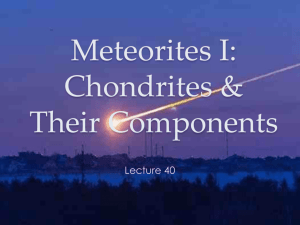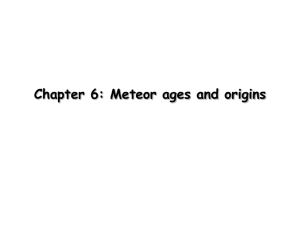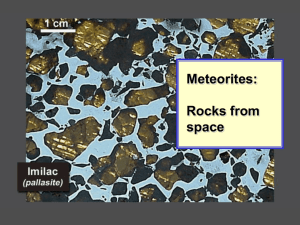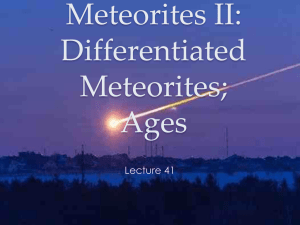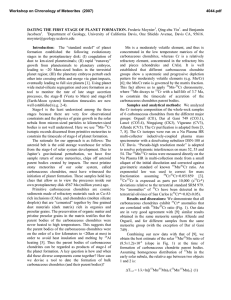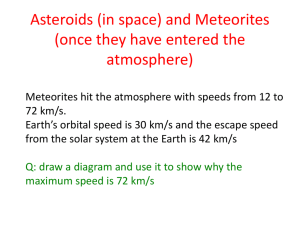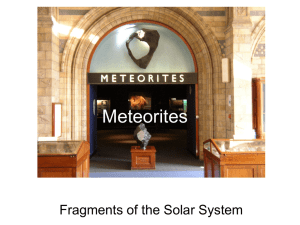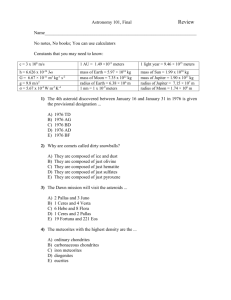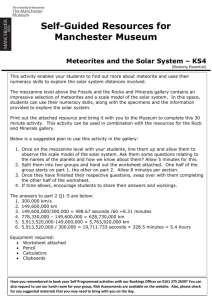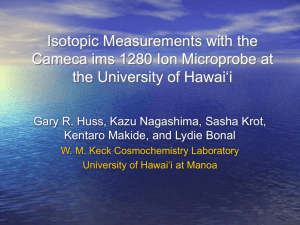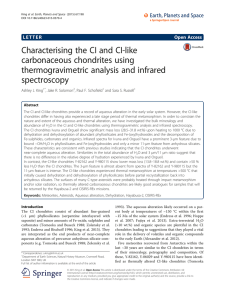Chapter 5. Isotope Cosmochemistry
advertisement
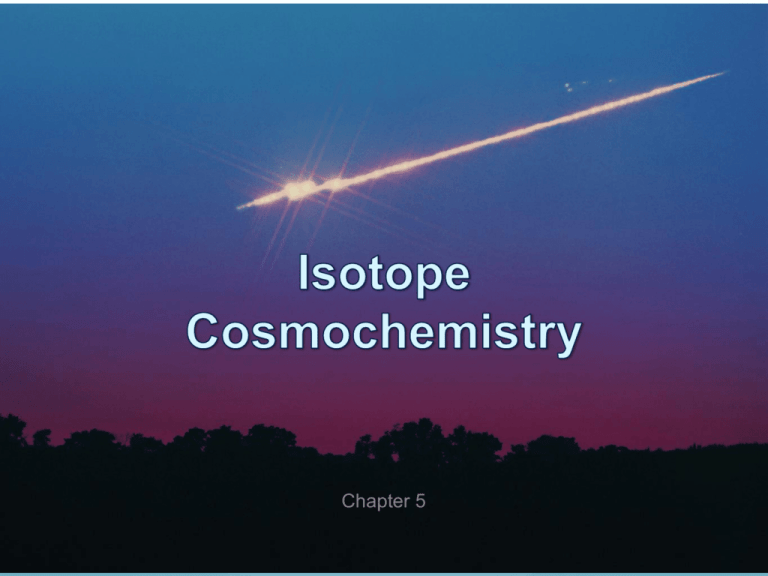
Chapter 5 Meteorites Primitive Chondrites (stones) Ordinary Chondrites (H, L, LL) Enstatite Chondrites (EH, EL) Carbonaceous Chondrites (CI, CV, CM, CO, etc) Misc. rarer classes Further subdivided by ‘petrologic grade’ 1-2: hydrous low-T alteration 3: least altered 4-6: high-T metamorphosed Differentiated Meteorites Achondrites (stones) primitive HED (from Vesta) Lunar (very rare) SNC (from Mars) misc. Irons Magmatic (cores of asteroids) Non-magmatic (but nevertheless were molten) Stony Irons Pallasites Mesosiderites Chondrite Components Calcium-aluminum Inclusions (CAI’s): very high-T condensates or evaporative residues Chondrules once molten droplets Ameboidal Olivine Aggregates (AOA’s): high-T condensates Pb-Pb Ages of meteorites & components 4568.22±0.17 Ma CAI’s are oldest objects Little difference between achondrites & chondrites K-Ar (40-39) Ages of Ordinary Chondrites K-Ar ages are often younger than other ages Results from shock-resetting of K-Ar ages. 4-Vesta as seen by DAWN Eucrites, many of which are brecciated, yield K-Ar ages with peaks in the distribution occurring at 4.48 Ga, 4.0 to 3.7 Ga and 3.45-3.55 Ga, which date heating from large impacts on the surface. On to 1-Ceres! Short-lived Radionuclides and the evolution of the solar nebula and formation of planetary bodies Short-lived Chronometers Table 5.1. Important short-Lived Radionuclides in the Early Solar System Radio- Half-life Decay Daughter Initial Abundance nuclide Ma Ratio 10Be 10B 10Be/9Be ~ 7.5 × 10–4 1.5 β 26Al 26Mg 26Al/27Al = 5.2 × 10–5 0.73 β 36Cl 36Ar/36S 36Cl/35Cl ~ 17 × 10-6 0.301 β 41Ca 41K 41Ca/40Ca ~1.4 × 10–8 0.15 β 53Mn 53Cr 53Mn/55Mn = 6.3 × 10–5 3.7 β 60Fe 60Ni 60Fe/56Fe ~ 5.8 × 10–8 1.5 β 107Pd 107Ag 107Pd/108Pd ~ 5.9 × 10–4 9.4 β 129I 129Xe 129I/127I ~ 1.2 × 10–4 16 β 146Sm 142Nd 146Sm/144Sm ~ 0.0094 103 α 182Hf 182W 182Hf/180Hf ~ 9.7 × 10–5 9 β 244Pu 244Pu/238U ~ 0.001 82 α, SF Xe 247Cm 247Cm/235U ~ 6 × 10-5 15.6 α, SF 235U Short-Lived Chronometers For these isotopes, the parent has entirely decayed and what we want to know was the initial abundance of the parent (N0). As was the case for the isochron equation, we start with: D* = N 0 - N But rather than substituting for N0, we substitute for N using - lt N = N0e And obtain: D* = N 0 (1- e- lt ) The equation for D is then D = D0 + N0 (1- e- lt ) 53Mn–53Cr Example Written for the 55Mn–55Cr decay, we have: Cr æ 53 Cr ö æ 53 Mn ö = ç 52 ÷ + ç 52 ÷ (1- e- lt ) 52 Cr è Cr ø 0 è Cr ø 0 53 We do not know the 53Mn/52Cr ratio, but we measure the 55Mn/53Cr ratio. Assuming that initial isotopic composition of Mn was homogeneous the initial 53Mn/52Cr ratio is: æ 53 Mn ö æ çè 52 Cr ÷ø = çè 0 Mn ö æ 52 Cr ÷ø 0 çè 55 53 55 Mn ö Mn ÷ø 0 Substituting and noting that e–λt = 0: Cr æ 53 Cr ö æ = + 52 Cr çè 52 Cr ÷ø 0 çè 53 Mn ö æ 52 Cr ÷øx0 çè 55 53 55 Mn ö Mn ÷ø 0 53Mn–53Cr Our equation: Cr æ 53 Cr ö æ = + 52 Cr çè 52 Cr ÷ø 0 çè 53 Mn ö æ 52 Cr ÷ø çè 55 53 55 Mn ö Mn ÷ø 0 has the form y =a + bx where b =( 55Mn/53Mn) , so plotting 53Cr/52Cr vs 0 55Mn/52Cr, the slope is proportional to the initial Mn isotopic composition, and the intercept gives the initial Cr isotopic composition. Both the ( 55Mn/53Mn)0 and the (53Cr/52Cr)0 are functions of time and allow us to assign relative ages to objects. We can then calibrate these relative ages against absolute chronometers such as Pb-Pb. 129I–129Xe The first short-lived radionuclide discovered was 129I, recognized from variable 129Xe/130Xe ratios. 128Xe (a minor isotope of Xe) can be produced by neutron capture of 127I by irradiation in a reactor. The 128Xe/130Xe is then proportional to 127I/130Xe. Very much analogous to 40Ar–39Ar dating, an ‘isochron’ can be produced by step-heating of the irradiated sample. Natural ratio Heavy Isotopes of Xe: 244 Evidence of Pu fission I-Xe Calibrated Chronology 107Pd–107Ag Pd and Ag (t1/2 = 9.4 Ma) are siderophile elements concentrated in iron meteorites, so this system is useful in dating iron meteorites. Most magmatic irons have Pd-Ag ages less than 10 Ma after CAI formation. Planetesimals formed and differentiated into mantles and cores quite early! 26Al–26Mg This is arguably the most significant decay system because: Half-live is short: 0.73 Ma, providing for detailed chronology Both elements are relatively abundant, making analysis relatively easy. Amount of 26Al in early solar system was sufficient to be a significant source of heat in early-formed bodies and may partly explain why they melted and differentiated. Initial 26Al/27Al in various objects Early Solar System Overview 182Hf–182W The 182Hf–182W chronometer (t1/2 = 9 Ma) is particularly interesting because Hf is lithophile and concentrates in the silicate parts of planetary bodies, W is siderophile and concentrates in the cores of planetary bodies. Notation: 182W/184W ratio reported in εW notation - deviations in parts per 10,000. However, unlike 143Nd/144Nd and 176Hf/177Hf, the deviations are from a terrestrial standard. All modern terrestrial rocks reported thus far have εW, so this value is also thought to be that of the bulk silicate Earth. Variation in 182W/184W are small, so a second notation, μw, variations in ppm from a terrestrial standard, is also used. Dating Core Formation The fractionation of Hf from W results from segregation of metal from silicate and hence dates the timing of core formation. The Earth’s formation was thought to be essentially completed by the Moon forming impact, which would have been the last opportunity for W isotopic equilibration between the mantle and core. This last equilibration is thought to date the ‘age of the Earth’. 182Hf–182W measurements of magmatic irons indicates planetesimal (asteroidal) cores formed within a few million years of CAI formation. When did the Earth’s core form? Initial measurements suggested the Earth’s 182W/184W was the same as chondrites (undifferentiated), suggesting core formation happened after 182Hf was extinct. Subsequent measurements showed chondrites have εW ≈ –2, indicating the Earth’s core formed before 182Hf was extinct. The moon also apparently has εW ≈ 0, suggesting core formation was largely complete before the Moon-forming impact. Two scenarios: The Earth’s core formed in a single event (perhaps triggered by the Moon-forming impact). In this case, dating core formation with Hf-W is straightforward. The planetesimals that accreted to form the Earth has already differentiated into silicate mantles and iron cores. How much W isotopic equilibration happened as these bodies accreted and their cores merged with the Earth’s core? Dating in this case is complex and model-dependent. εW in Solar System Materials Modeling Earth-Moon Formation f is the Hf/W difference between the silicate Earth and the silicate Moon. Post-Script Subsequent studies have identified small variations in εW in Archean rocks. Initial interpretation was that this reflected addition of a late accretionary veneer of chondritic material that had not yet been mixed into the Earth. 146Sm–142Nd 146Sm alpha decays to 142Nd with a half-life of 103 Ma. 142Nd excesses first identified in the eucrite Juvinas several decades ago. Long half-life suggests in should have survived in the early Earth. First evidence found in 3.8 Ga rocks from Isua, Greenland in 1990’s, but not confirmed for a decade later. Values reported as ε142Nd or as μ142Nd deviations from a terrestrial standard. Since both Sm and Nd are refractory lithophile elements, we expect the Sm/Nd ratio of the Earth to be chondritic and therefore the 142Nd/144Nd ratio of the bulk Earth to be identical to chondrites. Guess what? ε142Nd Variations in Terrestrial and Solar System Materials All modern terrestrial rocks have uniform ε142Nd =0, but 20 ppm greater than ordinary chondrites. Carbonaceous chondrites averageε142Nd = –0.4, enstatite chondrites average ε142Nd= –0.1. Variable ε142Nd have now been found in many Archean rocks, particularly Eoarchean rocks. ε142Nd is even more variable in meteorites from Vesta and Mars. The Moon appears to have average ε142Nd = 0 (same as observable Earth). How do we explain this? 1. Isotopically heterogeneous solar nebula 146Sm is a p-only nuclide produced in small quantities in supernovae. Analysis of other isotopes (e.g., 148Nd) shows anticorrelated variations in r- and s-process nuclides, suggesting a late addition of supernova debris that did not completely mix. (But is possible this results from incomplete dissolution of pre-solar grains present in meteorites). Earth still plots 10 ppm off correlation. 2. Formation of an Early Enriched Reservoir Boyet and Carlson proposed that an incompatible-element (and therefore low Sm/Nd) reservoir formed early in Earth’s history, sunk to the deep mantle and has remained there ever since. The crust and rest of the mantle and all subsequent volcanic rocks are derived from the Early Depleted Reservoir (with high Sm/Nd and therefore high 142Nd/144Nd). Issues with the EER Moon and Earth has the same ε142Nd – so the hypothetical EER would have had to form before (and hence survive) the Moon forming impact. A very substantial fraction (50%) of the Earth’s U, Th, and K would also end up in the EER, meaning very high heat production in it. This would ultimately make it dynamically unstable (should rise). But, could the LLSVP’s be the EER? Hypothesis 3: Collisional erosion produces a non-chondritic Earth As planets grow, collisions are energetic enough to partially melt them; producing a magma ocean that crystallizes to produce an incompatible element-enriched crust. Collisions also blast away a fraction of this crust, depleting the planet of elements enriched in the crust (incompatible elements). (Caro et al., 2008). There is indeed a growing body of evidence from astronomy and dynamic modeling that planetary accretion is a non-conservative process. Mercury’s core is way too big. Could collisional erosion be the explanation? Short-lived Radionuclide Summary Short-lived, extinct radionuclides provide a chronology of the early-solar system, including nebular processing and early planetary differentiation. They also provide evidence of the presence of newly synthesized elements in the solar nebula. Some, such as 10Be likely synthesized by spallation in high energy environments within the nebula. Others, such as 26Al, likely synthesized in red giants (AGB stars) and seeded into surrounding galaxy by their very enhanced solar winds. Yet others, such as 60Fe, likely produced in supernovae. Finally, some long-lived ones, such as 129I and 182Hf, have abundances similar to steady-state galactic background (maintained by occasional supernovae). Short-lived Radionuclides & Star Formation Stars are born in stellar nurseries, such as the Great Nebula in Orion when (small) parts of these nebulae collapse under gravity. The stars formed may include a few very large ones, with very short lives that could feed newly synthesized elements into the nebulae while younger stars are still forming. Did a shockwave from nearby supernova trigger the collapse that resulted in formation of the Sun? Smaller, longer-lived stars eventually wander away from the nebular birthplaces. High-Energy Jets from DG Forming Star Tau B Star Dust and Isotopic Anomalies in Meteorites Neon Alphabet Soup Xe-S Isotopic anomalies in Xe found in SiC grains in Allende (CV-3). Associated with Neon E(L) Likely s-process enrichments - similar to calculated production in AGB stars Xe-HL Pre-Solar SiC Grain C and N isotopes in SiC grains from Murchison (CM2) Mo Isotopes in SiC & graphite Oxygen Isotopes in Meteorites O isotopes in Meteorites Laboratory Induced MassIndependent Fractionation CO Self-Shielding Hypothesis Sun is 16O-rich Mass-Dependent Fractionation within Classes Cosmic Ray Exposure Ages of Ordinary Chondrites
